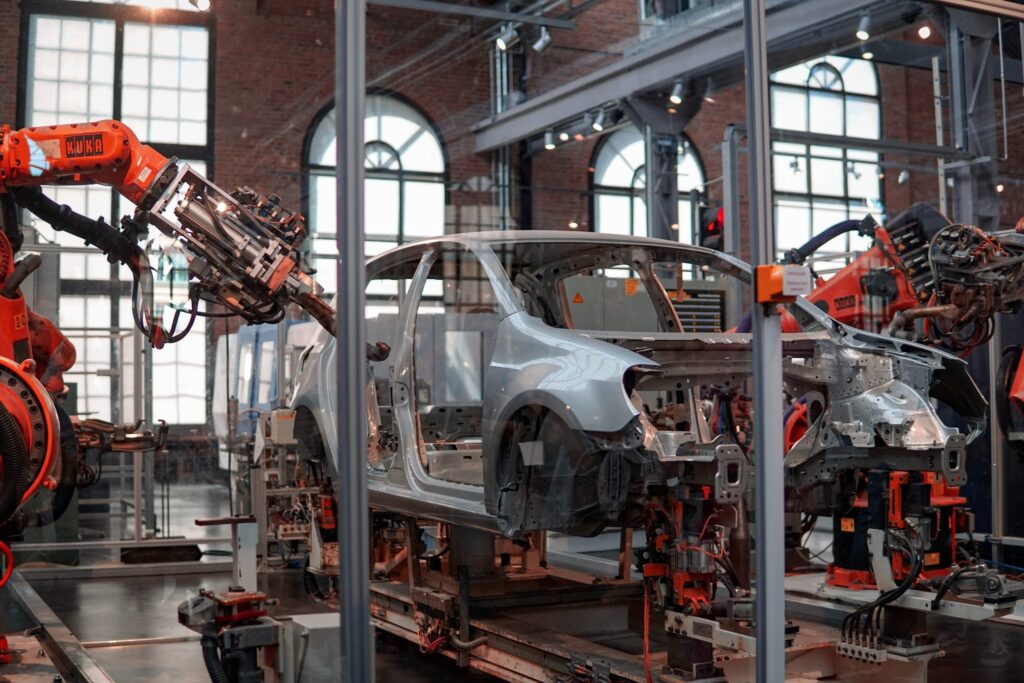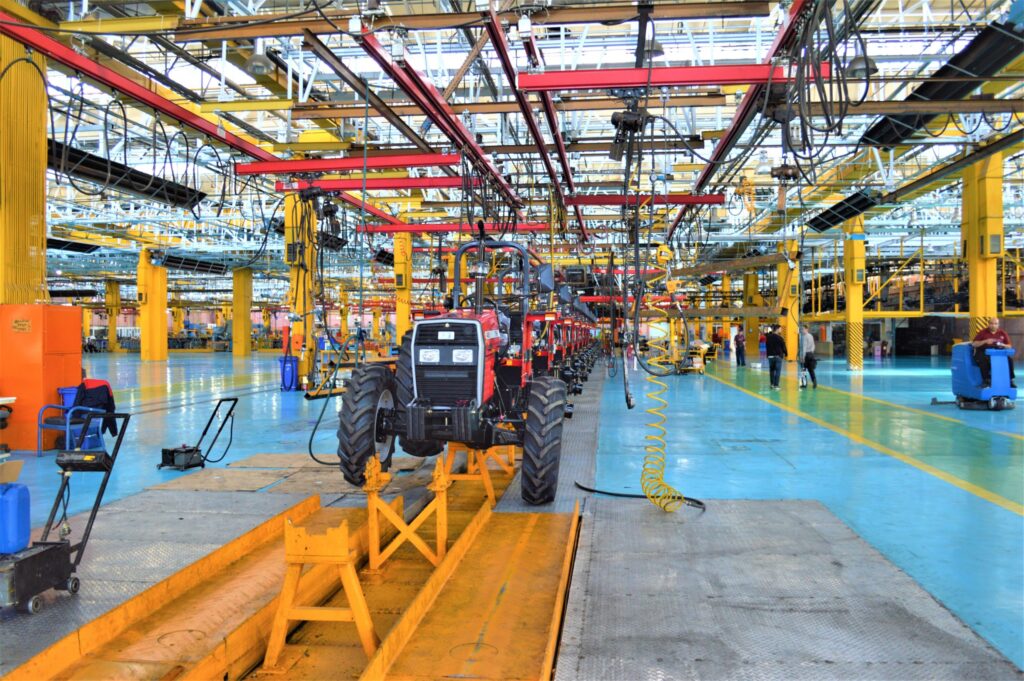Industry 4.0: Triumph of robots, defeat for humans?

Is Germany failing to keep pace with the global digitization trend in industry?
Made in Germany – the globally recognized seal of origin stands for quality and reflects the country’s production power. The world’s leading exporters have established themselves self-confidently through innovations. However, Germany is more cautious when it comes to implementing industry 4.0 technologies. According to the European Private Business Survey 2019, the Federal Republic attaches less importance to digital applications than its European neighbours. Comparitech carried out a comparative study and found that only 20% of all industrial robots used worldwide are located in Europe – more than 60% are in China. The figures also reveal that German building contractors are pessimistic: Over 57% see themselves as late adopters of Internet of Things (IoT) technologies.
But Germany is now back to its role as an industry pioneer. Amazing 91% of German industrial and manufacturing companies are already investing in digitally networked factories. With the German Research Center for Artificial Intelligence (DFKI), a separate research institution has been founded to promote digitization with highly qualified employees. The Federal Government has set itself the goal of raising the research, development and application of artificial intelligence to a worldwide leading level. Germany sees itself prepared for the changes industry 4.0 will bring.
Is Germany failing to keep pace with the global digitization trend in industry?
Made in Germany – the globally recognized seal of origin stands for quality and reflects the country’s production power. The world’s leading exporters have established themselves self-confidently through innovations. However, Germany is more cautious when it comes to implementing industry 4.0 technologies. According to the European Private Business Survey 2019, the Federal Republic attaches less importance to digital applications than its European neighbours. Comparitech carried out a comparative study and found that only 20% of all industrial robots used worldwide are located in Europe – more than 60% are in China. The figures also reveal that German building contractors are pessimistic: Over 57% see themselves as late adopters of Internet of Things (IoT) technologies.
But Germany is now back to its role as an industry pioneer. Amazing 91% of German industrial and manufacturing companies are already investing in digitally networked factories. With the German Research Center for Artificial Intelligence (DFKI), a separate research institution has been founded to promote digitization with highly qualified employees. The Federal Government has set itself the goal of raising the research, development and application of artificial intelligence to a worldwide leading level. Germany sees itself prepared for the changes industry 4.0 will bring.

How can digital signage be used in industry?
The idea of the Smart Factory implies that the production should be carried out completely independently, however, humans are not deleted from the equation. With the changing industrial environment, the requirement profiles of employees also change. In the future, the way in which employees are involved in the production cycle will change dramatically. Since all devices and machines can communicate with each other and are embedded in a secure system environment, it is no longer necessary to monitor all work steps. If, for example, a repair is due or a water tank is unexpectedly emptied, the employee is informed. On large-area digital signage solutions, all information is collected in a central control unit. All machine activities and information on further procedures can be displayed here. Digital signage represents the visual communication channel between man and machine – the interface of the Smart Factory. This is illustrated in the following scenarios:
- More transparent production
In order to be able to produce as efficiently as possible, it is important to gain a deep insight into the production chain. Errors would be detected immediately and countermeasures taken to rectify them. Measuring stations of the quality assurance or other places supply data to a server, which forwards these again to screens. In addition to mobile solutions, this data can be visualized on digital signage boards to make the manufacturing process more transparent. - Easily accessible warehouse data
Keeping an overview in warehouses is an extremely stressful task. No delivery should be incomplete, because such inattention can quickly have a negative effect on customer relations. The use of digital signage modules can provide employees with information at a glance as to whether a delivery is complete and ready for export. It can also be used to determine which loads are currently being dispatched in order to be able to provide suitable means of unloading if necessary. It is also possible to transmit data on stock levels or delivery bottlenecks. - Danger prediction through monitoring
In industrial plants with the storage of raw materials in shells and silos, other operating parameters can be displayed on totems. This also takes a safety aspect into account: Some fillings can react to pressure and temperature changes and could potentially explode. This danger should be detected early on by employees. - Planning
The production plant is the heart of every company in the manufacturing industry. But not only the core, but also the shell has to meet many requirements. Digital signage boards are enormously helpful in the planning of industrial halls and warehouses. They depict virtual reality in detail and clearly. Using touch gestures, employees can add, edit or delete individual virtual elements. - Wayfinding
Warehouses – an almost limitless maze filled with boxes. To help employees find their way around, a map can be shown on the displays. This enables them to find their way around, for example by showing them the right way to a certain hall area during commissioning. This makes it easier for new employees, in particular, to get on board, as they can use the guidance system. Due to increasingly larger and more complex warehouses and factories, Wayfinding is a hot topic in the industry.
How can digital signage be used in industry?
The idea of the Smart Factory implies that the production should be carried out completely independently, however, humans are not deleted from the equation. With the changing industrial environment, the requirement profiles of employees also change. In the future, the way in which employees are involved in the production cycle will change dramatically. Since all devices and machines can communicate with each other and are embedded in a secure system environment, it is no longer necessary to monitor all work steps. If, for example, a repair is due or a water tank is unexpectedly emptied, the employee is informed. On large-area digital signage solutions, all information is collected in a central control unit. All machine activities and information on further procedures can be displayed here. Digital signage represents the visual communication channel between man and machine – the interface of the Smart Factory. This is illustrated in the following scenarios:
- More transparent production
In order to be able to produce as efficiently as possible, it is important to gain a deep insight into the production chain. Errors would be detected immediately and countermeasures taken to rectify them. Measuring stations of the quality assurance or other places supply data to a server, which forwards these again to screens. In addition to mobile solutions, this data can be visualized on digital signage boards to make the manufacturing process more transparent. - Easily accessible warehouse data
Keeping an overview in warehouses is an extremely stressful task. No delivery should be incomplete, because such inattention can quickly have a negative effect on customer relations. The use of digital signage modules can provide employees with information at a glance as to whether a delivery is complete and ready for export. It can also be used to determine which loads are currently being dispatched in order to be able to provide suitable means of unloading if necessary. It is also possible to transmit data on stock levels or delivery bottlenecks. - Danger prediction through monitoring
In industrial plants with the storage of raw materials in shells and silos, other operating parameters can be displayed on totems. This also takes a safety aspect into account: Some fillings can react to pressure and temperature changes and could potentially explode. This danger should be detected early on by employees. - Planning
The production plant is the heart of every company in the manufacturing industry. But not only the core, but also the shell has to meet many requirements. Digital signage boards are enormously helpful in the planning of industrial halls and warehouses. They depict virtual reality in detail and clearly. Using touch gestures, employees can add, edit or delete individual virtual elements. - Wayfinding
Warehouses – an almost limitless maze filled with boxes. To help employees find their way around, a map can be shown on the displays. This enables them to find their way around, for example by showing them the right way to a certain hall area during commissioning. This makes it easier for new employees, in particular, to get on board, as they can use the guidance system. Due to increasingly larger and more complex warehouses and factories, Wayfinding is a hot topic in the industry.

Digital Signage as mediator between man and machine
The scenarios presented show the usefulness of digital signage in the industry 4.0 context. However, there are many other use cases where digital signage can help master digitization without any growth barriers. The trend towards more displays can also be seen in industry, as the digitally visualized, smart networked and interactive application offers numerous advantages over the old stationary display on the PC. With digital signage, people will be able to carry out a wide variety of activities in industrial manufacturing with just one touch.
The Smart Factory is equipped with incredibly intelligent networked technology. Industrial manufacturing as we know it will change fundamentally. Even if the plant works, communicates and maintains itself independently, the assembler, technician and warehouse worker will not be completely replaced. The activities of the employees change into a direction in which the person should act as a so to speak conductor. The dystopian nightmare of complete displacement by machines thus does not come true.
Digital Signage as mediator between man and machine
The scenarios presented show the usefulness of digital signage in the industry 4.0 context. However, there are many other use cases where digital signage can help master digitization without any growth barriers. The trend towards more displays can also be seen in industry, as the digitally visualized, smart networked and interactive application offers numerous advantages over the old stationary display on the PC. With digital signage, people will be able to carry out a wide variety of activities in industrial manufacturing with just one touch.
The Smart Factory is equipped with incredibly intelligent networked technology. Industrial manufacturing as we know it will change fundamentally. Even if the plant works, communicates and maintains itself independently, the assembler, technician and warehouse worker will not be completely replaced. The activities of the employees change into a direction in which the person should act as a so to speak conductor. The dystopian nightmare of complete displacement by machines thus does not come true.